Public Health Project: Malaria Prevention in Pregnant Women, Ghana
VerifiedAdded on 2022/09/18
|9
|1764
|42
Homework Assignment
AI Summary
This assignment addresses the critical public health issue of malaria prevention among pregnant women in Ghana. It begins by identifying the problem through a literature review, emphasizing the increased vulnerability of pregnant women to malaria and its adverse effects. The project's objective is to explore knowledge of malaria and identify risk factors associated with insecticide-treated nets (ITNs) in Ashanti, Ghana. The assignment outlines research questions, target, investigative, and sample populations, and proposes a survey research design as the most feasible quantitative approach. It identifies study factors, outcomes, and potential confounding factors, followed by sample size calculation and a random sampling strategy. Finally, the assignment includes a detailed survey questionnaire designed to collect data on malaria knowledge, ITN usage, and related factors. The references used in the study are also provided.
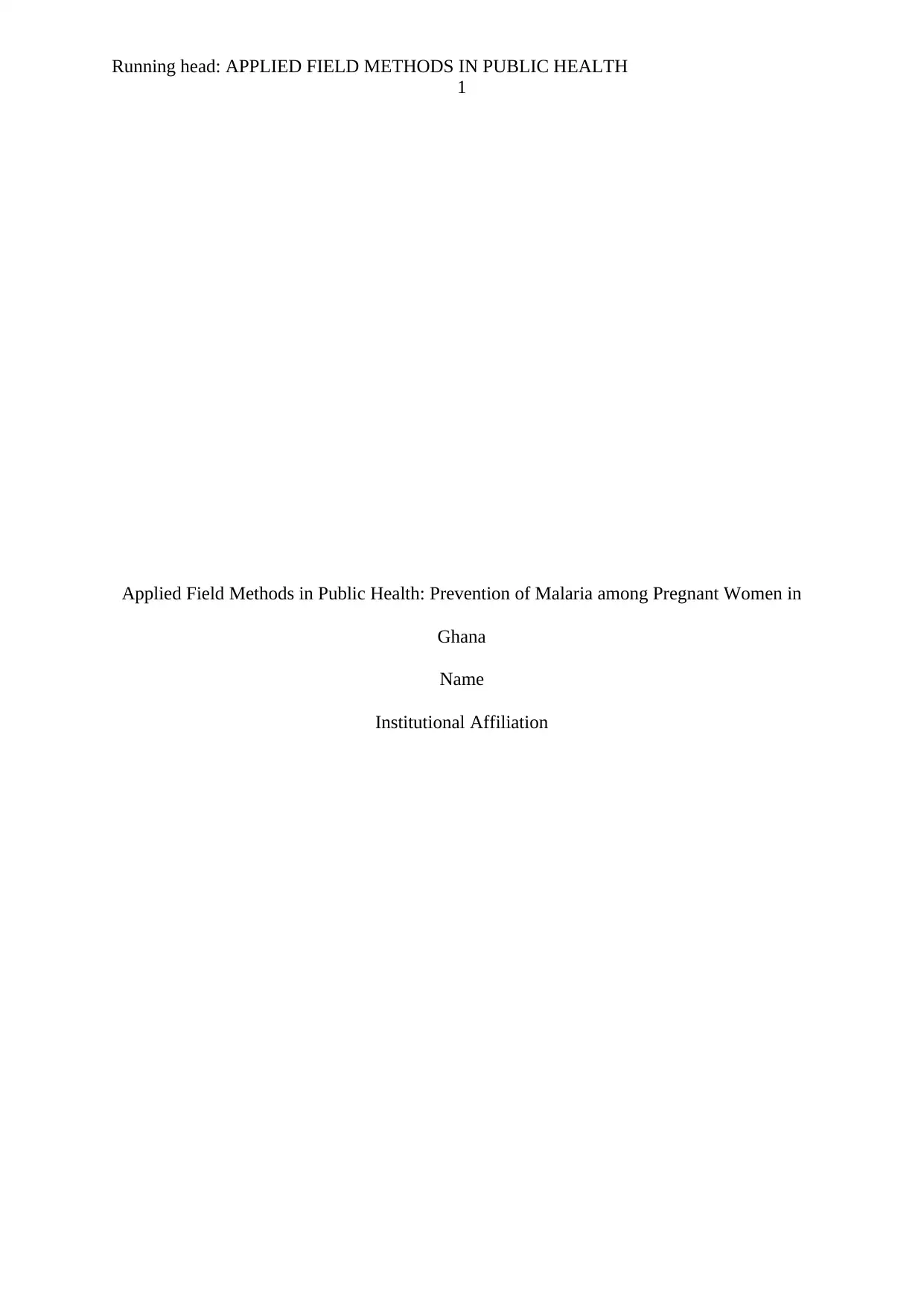
Running head: APPLIED FIELD METHODS IN PUBLIC HEALTH
1
Applied Field Methods in Public Health: Prevention of Malaria among Pregnant Women in
Ghana
Name
Institutional Affiliation
1
Applied Field Methods in Public Health: Prevention of Malaria among Pregnant Women in
Ghana
Name
Institutional Affiliation
Paraphrase This Document
Need a fresh take? Get an instant paraphrase of this document with our AI Paraphraser
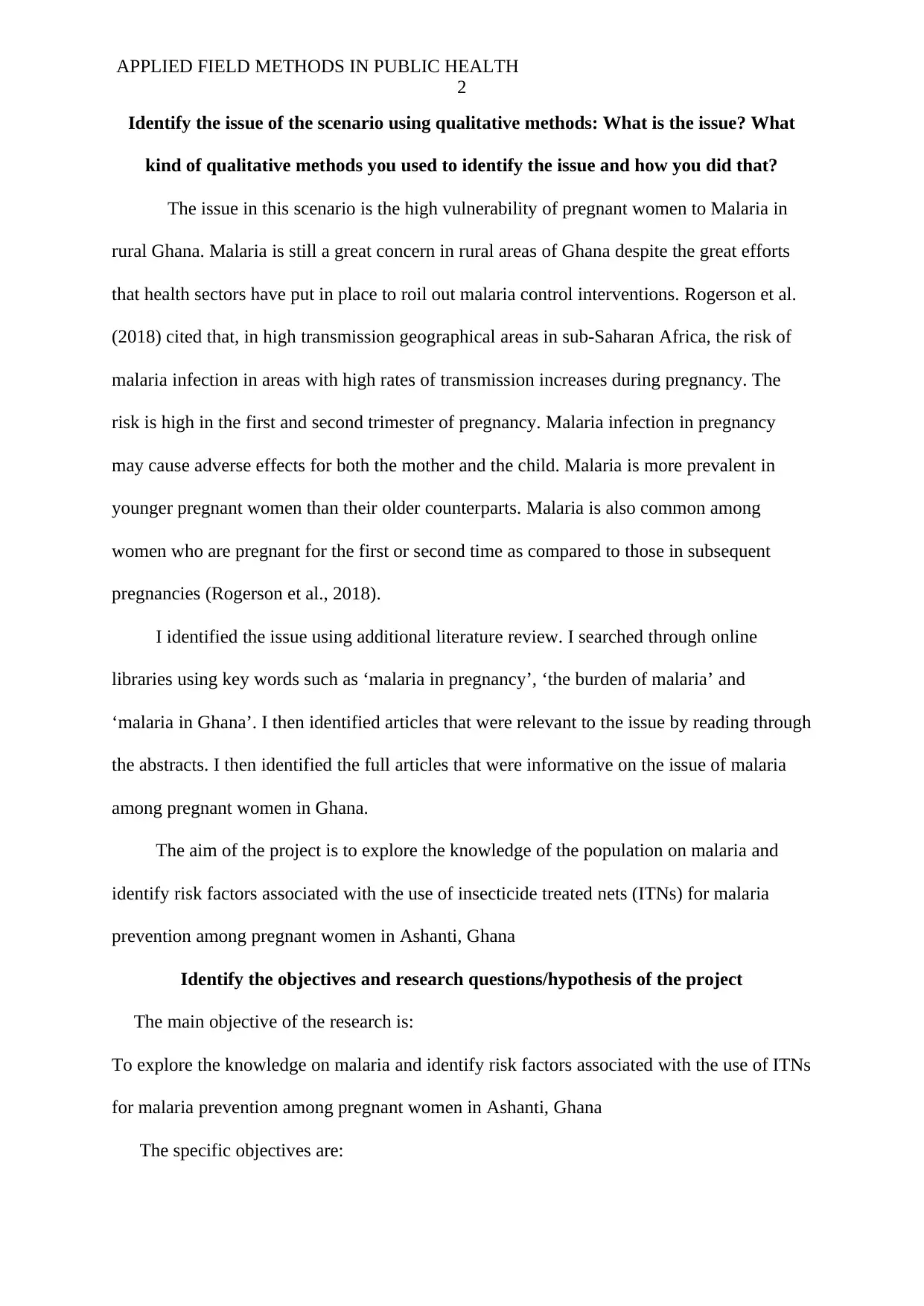
APPLIED FIELD METHODS IN PUBLIC HEALTH
2
Identify the issue of the scenario using qualitative methods: What is the issue? What
kind of qualitative methods you used to identify the issue and how you did that?
The issue in this scenario is the high vulnerability of pregnant women to Malaria in
rural Ghana. Malaria is still a great concern in rural areas of Ghana despite the great efforts
that health sectors have put in place to roil out malaria control interventions. Rogerson et al.
(2018) cited that, in high transmission geographical areas in sub-Saharan Africa, the risk of
malaria infection in areas with high rates of transmission increases during pregnancy. The
risk is high in the first and second trimester of pregnancy. Malaria infection in pregnancy
may cause adverse effects for both the mother and the child. Malaria is more prevalent in
younger pregnant women than their older counterparts. Malaria is also common among
women who are pregnant for the first or second time as compared to those in subsequent
pregnancies (Rogerson et al., 2018).
I identified the issue using additional literature review. I searched through online
libraries using key words such as ‘malaria in pregnancy’, ‘the burden of malaria’ and
‘malaria in Ghana’. I then identified articles that were relevant to the issue by reading through
the abstracts. I then identified the full articles that were informative on the issue of malaria
among pregnant women in Ghana.
The aim of the project is to explore the knowledge of the population on malaria and
identify risk factors associated with the use of insecticide treated nets (ITNs) for malaria
prevention among pregnant women in Ashanti, Ghana
Identify the objectives and research questions/hypothesis of the project
The main objective of the research is:
To explore the knowledge on malaria and identify risk factors associated with the use of ITNs
for malaria prevention among pregnant women in Ashanti, Ghana
The specific objectives are:
2
Identify the issue of the scenario using qualitative methods: What is the issue? What
kind of qualitative methods you used to identify the issue and how you did that?
The issue in this scenario is the high vulnerability of pregnant women to Malaria in
rural Ghana. Malaria is still a great concern in rural areas of Ghana despite the great efforts
that health sectors have put in place to roil out malaria control interventions. Rogerson et al.
(2018) cited that, in high transmission geographical areas in sub-Saharan Africa, the risk of
malaria infection in areas with high rates of transmission increases during pregnancy. The
risk is high in the first and second trimester of pregnancy. Malaria infection in pregnancy
may cause adverse effects for both the mother and the child. Malaria is more prevalent in
younger pregnant women than their older counterparts. Malaria is also common among
women who are pregnant for the first or second time as compared to those in subsequent
pregnancies (Rogerson et al., 2018).
I identified the issue using additional literature review. I searched through online
libraries using key words such as ‘malaria in pregnancy’, ‘the burden of malaria’ and
‘malaria in Ghana’. I then identified articles that were relevant to the issue by reading through
the abstracts. I then identified the full articles that were informative on the issue of malaria
among pregnant women in Ghana.
The aim of the project is to explore the knowledge of the population on malaria and
identify risk factors associated with the use of insecticide treated nets (ITNs) for malaria
prevention among pregnant women in Ashanti, Ghana
Identify the objectives and research questions/hypothesis of the project
The main objective of the research is:
To explore the knowledge on malaria and identify risk factors associated with the use of ITNs
for malaria prevention among pregnant women in Ashanti, Ghana
The specific objectives are:
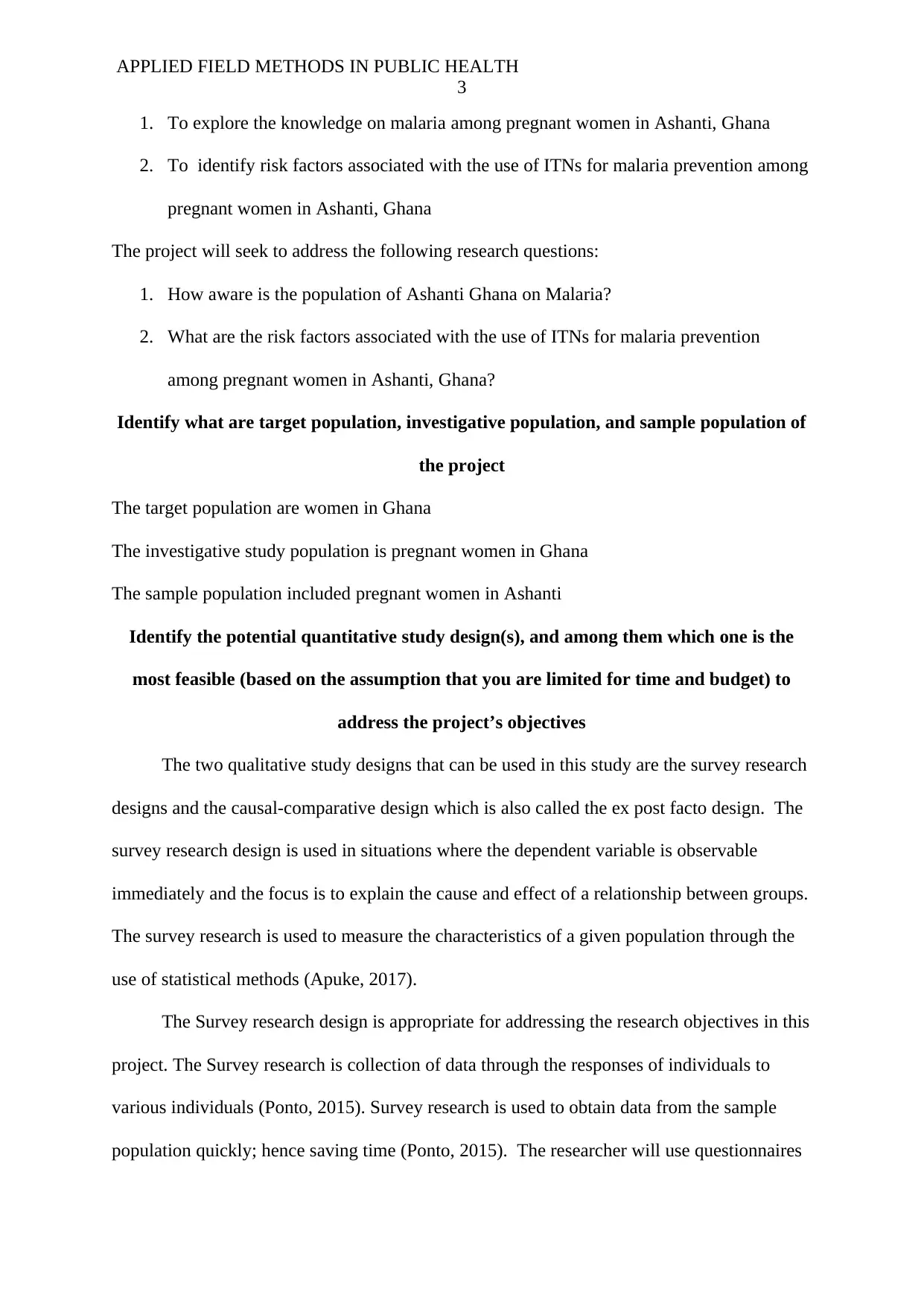
APPLIED FIELD METHODS IN PUBLIC HEALTH
3
1. To explore the knowledge on malaria among pregnant women in Ashanti, Ghana
2. To identify risk factors associated with the use of ITNs for malaria prevention among
pregnant women in Ashanti, Ghana
The project will seek to address the following research questions:
1. How aware is the population of Ashanti Ghana on Malaria?
2. What are the risk factors associated with the use of ITNs for malaria prevention
among pregnant women in Ashanti, Ghana?
Identify what are target population, investigative population, and sample population of
the project
The target population are women in Ghana
The investigative study population is pregnant women in Ghana
The sample population included pregnant women in Ashanti
Identify the potential quantitative study design(s), and among them which one is the
most feasible (based on the assumption that you are limited for time and budget) to
address the project’s objectives
The two qualitative study designs that can be used in this study are the survey research
designs and the causal-comparative design which is also called the ex post facto design. The
survey research design is used in situations where the dependent variable is observable
immediately and the focus is to explain the cause and effect of a relationship between groups.
The survey research is used to measure the characteristics of a given population through the
use of statistical methods (Apuke, 2017).
The Survey research design is appropriate for addressing the research objectives in this
project. The Survey research is collection of data through the responses of individuals to
various individuals (Ponto, 2015). Survey research is used to obtain data from the sample
population quickly; hence saving time (Ponto, 2015). The researcher will use questionnaires
3
1. To explore the knowledge on malaria among pregnant women in Ashanti, Ghana
2. To identify risk factors associated with the use of ITNs for malaria prevention among
pregnant women in Ashanti, Ghana
The project will seek to address the following research questions:
1. How aware is the population of Ashanti Ghana on Malaria?
2. What are the risk factors associated with the use of ITNs for malaria prevention
among pregnant women in Ashanti, Ghana?
Identify what are target population, investigative population, and sample population of
the project
The target population are women in Ghana
The investigative study population is pregnant women in Ghana
The sample population included pregnant women in Ashanti
Identify the potential quantitative study design(s), and among them which one is the
most feasible (based on the assumption that you are limited for time and budget) to
address the project’s objectives
The two qualitative study designs that can be used in this study are the survey research
designs and the causal-comparative design which is also called the ex post facto design. The
survey research design is used in situations where the dependent variable is observable
immediately and the focus is to explain the cause and effect of a relationship between groups.
The survey research is used to measure the characteristics of a given population through the
use of statistical methods (Apuke, 2017).
The Survey research design is appropriate for addressing the research objectives in this
project. The Survey research is collection of data through the responses of individuals to
various individuals (Ponto, 2015). Survey research is used to obtain data from the sample
population quickly; hence saving time (Ponto, 2015). The researcher will use questionnaires
⊘ This is a preview!⊘
Do you want full access?
Subscribe today to unlock all pages.

Trusted by 1+ million students worldwide
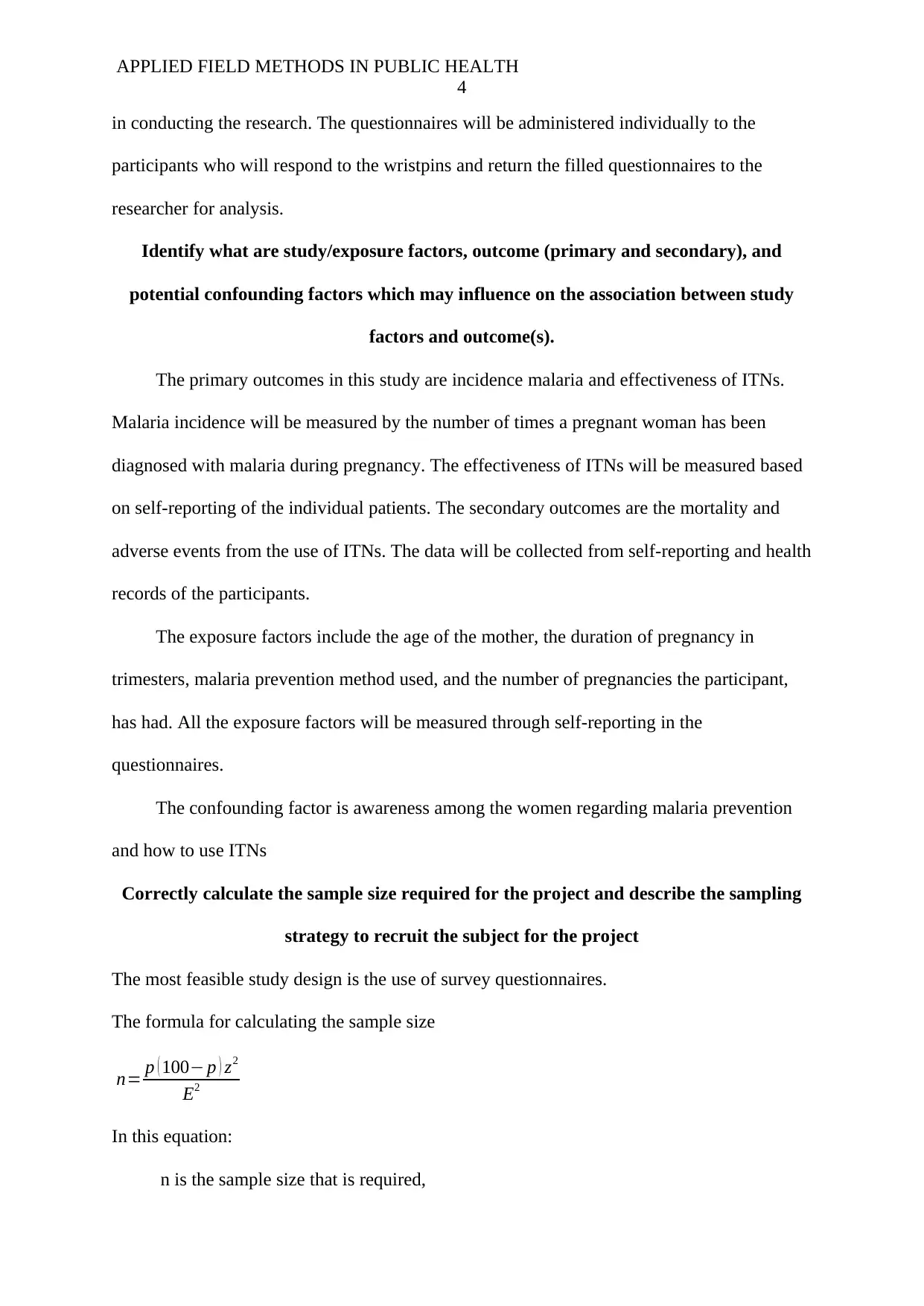
APPLIED FIELD METHODS IN PUBLIC HEALTH
4
in conducting the research. The questionnaires will be administered individually to the
participants who will respond to the wristpins and return the filled questionnaires to the
researcher for analysis.
Identify what are study/exposure factors, outcome (primary and secondary), and
potential confounding factors which may influence on the association between study
factors and outcome(s).
The primary outcomes in this study are incidence malaria and effectiveness of ITNs.
Malaria incidence will be measured by the number of times a pregnant woman has been
diagnosed with malaria during pregnancy. The effectiveness of ITNs will be measured based
on self-reporting of the individual patients. The secondary outcomes are the mortality and
adverse events from the use of ITNs. The data will be collected from self-reporting and health
records of the participants.
The exposure factors include the age of the mother, the duration of pregnancy in
trimesters, malaria prevention method used, and the number of pregnancies the participant,
has had. All the exposure factors will be measured through self-reporting in the
questionnaires.
The confounding factor is awareness among the women regarding malaria prevention
and how to use ITNs
Correctly calculate the sample size required for the project and describe the sampling
strategy to recruit the subject for the project
The most feasible study design is the use of survey questionnaires.
The formula for calculating the sample size
n= p ( 100− p ) z2
E2
In this equation:
n is the sample size that is required,
4
in conducting the research. The questionnaires will be administered individually to the
participants who will respond to the wristpins and return the filled questionnaires to the
researcher for analysis.
Identify what are study/exposure factors, outcome (primary and secondary), and
potential confounding factors which may influence on the association between study
factors and outcome(s).
The primary outcomes in this study are incidence malaria and effectiveness of ITNs.
Malaria incidence will be measured by the number of times a pregnant woman has been
diagnosed with malaria during pregnancy. The effectiveness of ITNs will be measured based
on self-reporting of the individual patients. The secondary outcomes are the mortality and
adverse events from the use of ITNs. The data will be collected from self-reporting and health
records of the participants.
The exposure factors include the age of the mother, the duration of pregnancy in
trimesters, malaria prevention method used, and the number of pregnancies the participant,
has had. All the exposure factors will be measured through self-reporting in the
questionnaires.
The confounding factor is awareness among the women regarding malaria prevention
and how to use ITNs
Correctly calculate the sample size required for the project and describe the sampling
strategy to recruit the subject for the project
The most feasible study design is the use of survey questionnaires.
The formula for calculating the sample size
n= p ( 100− p ) z2
E2
In this equation:
n is the sample size that is required,
Paraphrase This Document
Need a fresh take? Get an instant paraphrase of this document with our AI Paraphraser
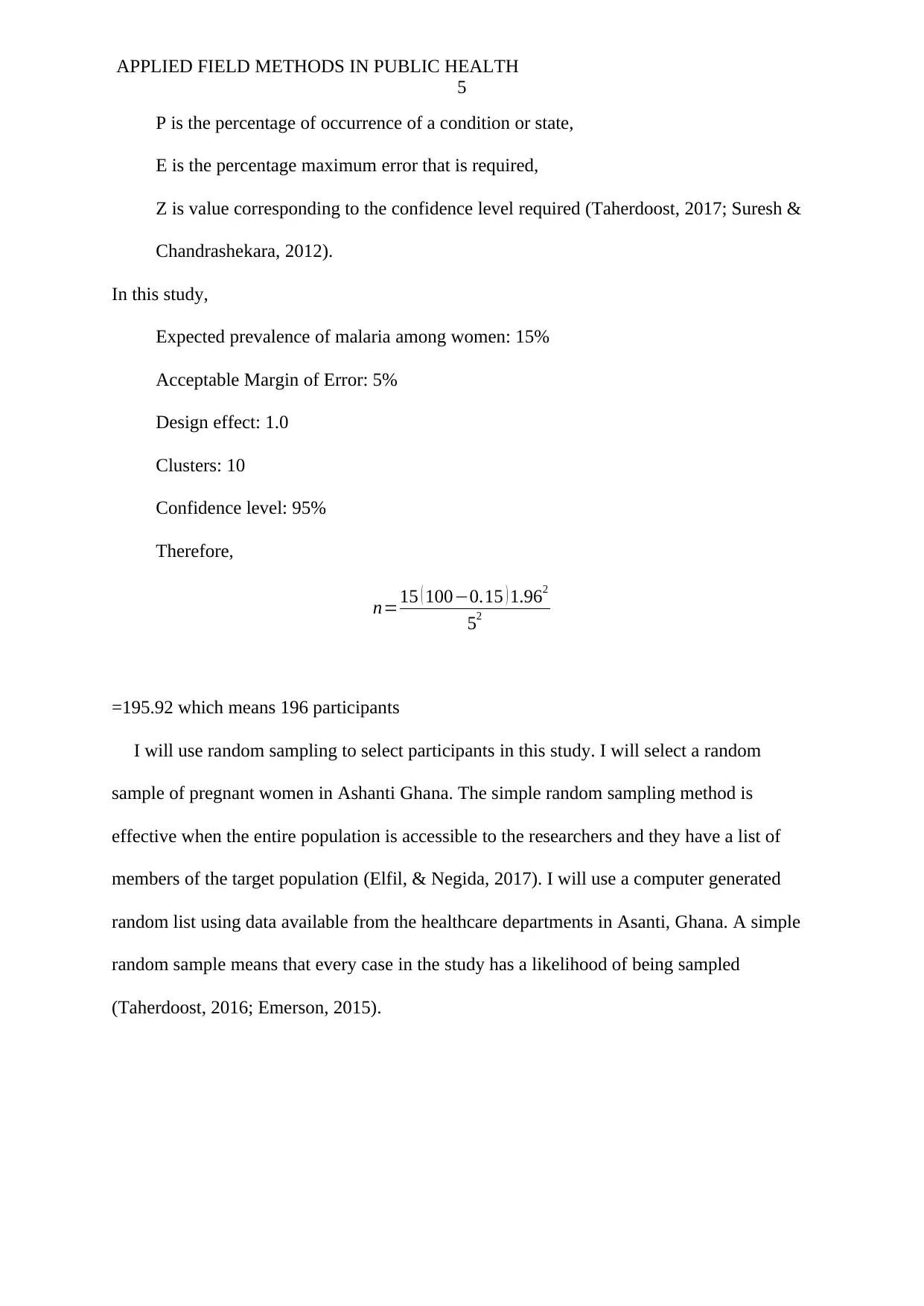
APPLIED FIELD METHODS IN PUBLIC HEALTH
5
P is the percentage of occurrence of a condition or state,
E is the percentage maximum error that is required,
Z is value corresponding to the confidence level required (Taherdoost, 2017; Suresh &
Chandrashekara, 2012).
In this study,
Expected prevalence of malaria among women: 15%
Acceptable Margin of Error: 5%
Design effect: 1.0
Clusters: 10
Confidence level: 95%
Therefore,
n=15 ( 100−0.15 ) 1.962
52
=195.92 which means 196 participants
I will use random sampling to select participants in this study. I will select a random
sample of pregnant women in Ashanti Ghana. The simple random sampling method is
effective when the entire population is accessible to the researchers and they have a list of
members of the target population (Elfil, & Negida, 2017). I will use a computer generated
random list using data available from the healthcare departments in Asanti, Ghana. A simple
random sample means that every case in the study has a likelihood of being sampled
(Taherdoost, 2016; Emerson, 2015).
5
P is the percentage of occurrence of a condition or state,
E is the percentage maximum error that is required,
Z is value corresponding to the confidence level required (Taherdoost, 2017; Suresh &
Chandrashekara, 2012).
In this study,
Expected prevalence of malaria among women: 15%
Acceptable Margin of Error: 5%
Design effect: 1.0
Clusters: 10
Confidence level: 95%
Therefore,
n=15 ( 100−0.15 ) 1.962
52
=195.92 which means 196 participants
I will use random sampling to select participants in this study. I will select a random
sample of pregnant women in Ashanti Ghana. The simple random sampling method is
effective when the entire population is accessible to the researchers and they have a list of
members of the target population (Elfil, & Negida, 2017). I will use a computer generated
random list using data available from the healthcare departments in Asanti, Ghana. A simple
random sample means that every case in the study has a likelihood of being sampled
(Taherdoost, 2016; Emerson, 2015).
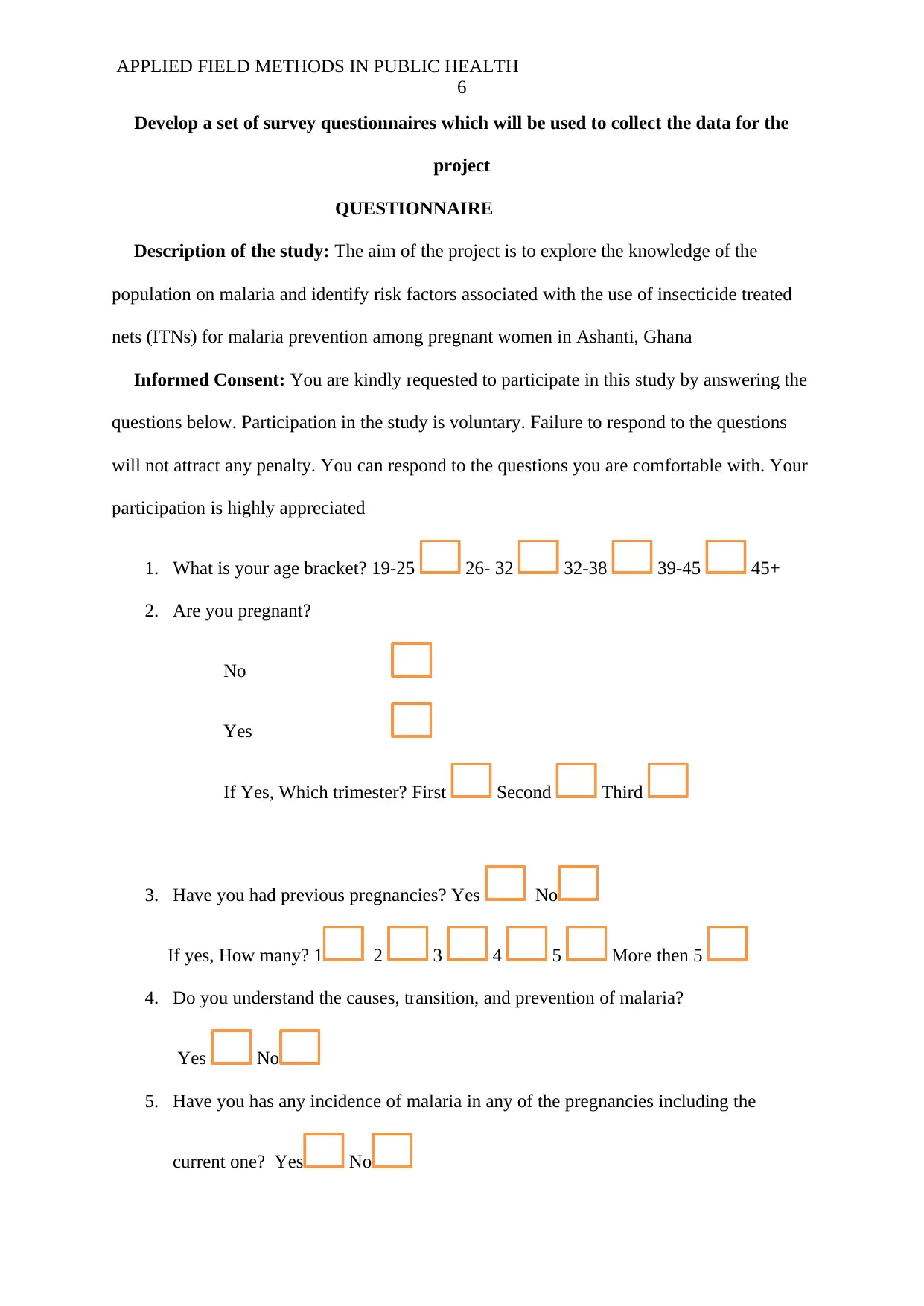
APPLIED FIELD METHODS IN PUBLIC HEALTH
6
Develop a set of survey questionnaires which will be used to collect the data for the
project
QUESTIONNAIRE
Description of the study: The aim of the project is to explore the knowledge of the
population on malaria and identify risk factors associated with the use of insecticide treated
nets (ITNs) for malaria prevention among pregnant women in Ashanti, Ghana
Informed Consent: You are kindly requested to participate in this study by answering the
questions below. Participation in the study is voluntary. Failure to respond to the questions
will not attract any penalty. You can respond to the questions you are comfortable with. Your
participation is highly appreciated
1. What is your age bracket? 19-25 26- 32 32-38 39-45 45+
2. Are you pregnant?
No
Yes
If Yes, Which trimester? First Second Third
3. Have you had previous pregnancies? Yes No
If yes, How many? 1 2 3 4 5 More then 5
4. Do you understand the causes, transition, and prevention of malaria?
Yes No
5. Have you has any incidence of malaria in any of the pregnancies including the
current one? Yes No
6
Develop a set of survey questionnaires which will be used to collect the data for the
project
QUESTIONNAIRE
Description of the study: The aim of the project is to explore the knowledge of the
population on malaria and identify risk factors associated with the use of insecticide treated
nets (ITNs) for malaria prevention among pregnant women in Ashanti, Ghana
Informed Consent: You are kindly requested to participate in this study by answering the
questions below. Participation in the study is voluntary. Failure to respond to the questions
will not attract any penalty. You can respond to the questions you are comfortable with. Your
participation is highly appreciated
1. What is your age bracket? 19-25 26- 32 32-38 39-45 45+
2. Are you pregnant?
No
Yes
If Yes, Which trimester? First Second Third
3. Have you had previous pregnancies? Yes No
If yes, How many? 1 2 3 4 5 More then 5
4. Do you understand the causes, transition, and prevention of malaria?
Yes No
5. Have you has any incidence of malaria in any of the pregnancies including the
current one? Yes No
⊘ This is a preview!⊘
Do you want full access?
Subscribe today to unlock all pages.

Trusted by 1+ million students worldwide

APPLIED FIELD METHODS IN PUBLIC HEALTH
7
6. What Malaria prevention strategies do you use? (eg. indoor residual house spraying,
cleaning the surrounding, closing windows and doors at night, use of insecticide
treated nets, use of curtains, drainage of mosquito breeding sites, use of anti malaria
tablets) __________________________________________________________
7. When using insect treated nets, did you suffer from malaria? No Yes
8. How do you perceive the use of insect treated nets for malaria prevention?
______________________________________________
9. Would you advice anybody to use insect-treated nets for malaria prevention?
No Yes
7
6. What Malaria prevention strategies do you use? (eg. indoor residual house spraying,
cleaning the surrounding, closing windows and doors at night, use of insecticide
treated nets, use of curtains, drainage of mosquito breeding sites, use of anti malaria
tablets) __________________________________________________________
7. When using insect treated nets, did you suffer from malaria? No Yes
8. How do you perceive the use of insect treated nets for malaria prevention?
______________________________________________
9. Would you advice anybody to use insect-treated nets for malaria prevention?
No Yes
Paraphrase This Document
Need a fresh take? Get an instant paraphrase of this document with our AI Paraphraser
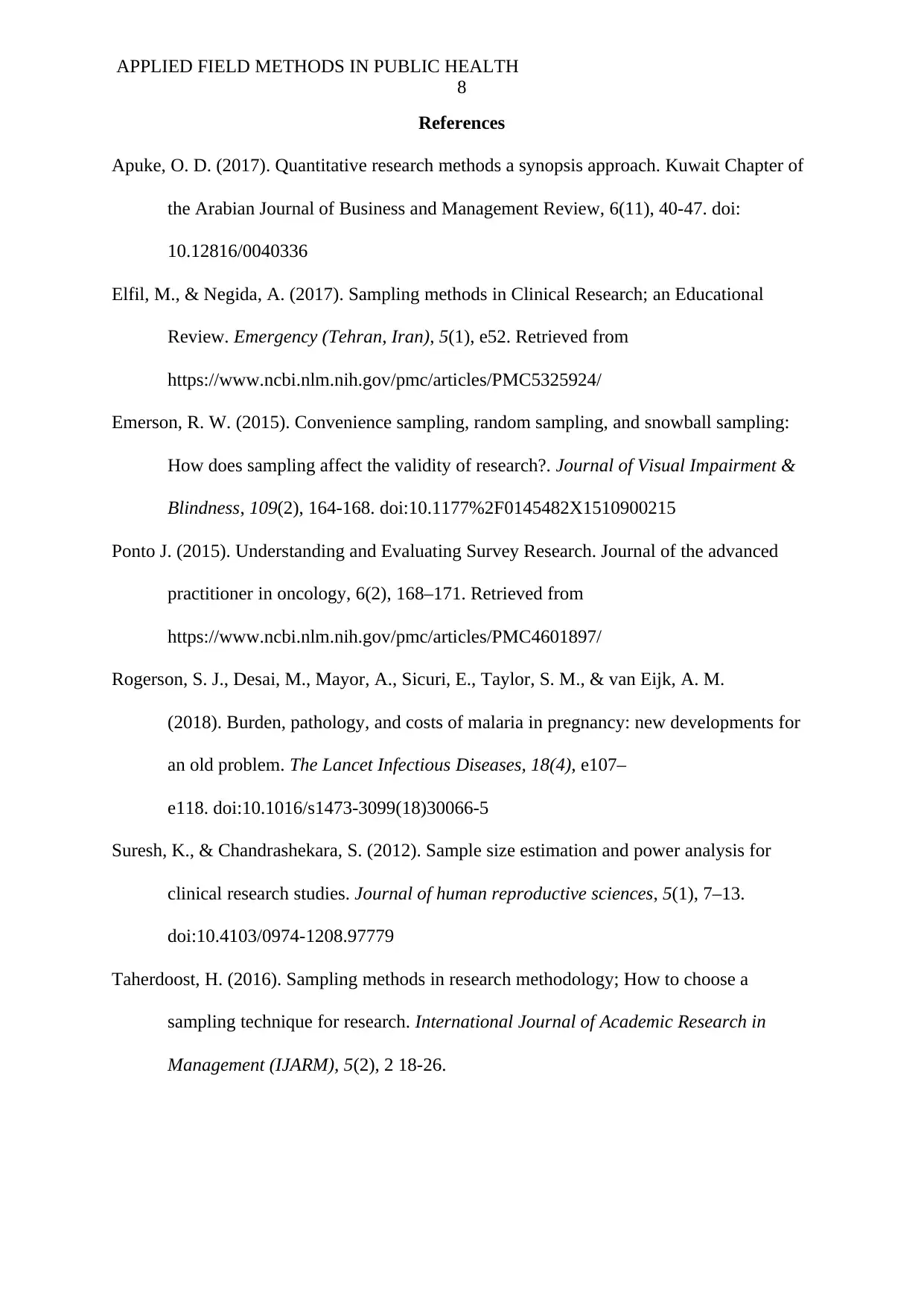
APPLIED FIELD METHODS IN PUBLIC HEALTH
8
References
Apuke, O. D. (2017). Quantitative research methods a synopsis approach. Kuwait Chapter of
the Arabian Journal of Business and Management Review, 6(11), 40-47. doi:
10.12816/0040336
Elfil, M., & Negida, A. (2017). Sampling methods in Clinical Research; an Educational
Review. Emergency (Tehran, Iran), 5(1), e52. Retrieved from
https://www.ncbi.nlm.nih.gov/pmc/articles/PMC5325924/
Emerson, R. W. (2015). Convenience sampling, random sampling, and snowball sampling:
How does sampling affect the validity of research?. Journal of Visual Impairment &
Blindness, 109(2), 164-168. doi:10.1177%2F0145482X1510900215
Ponto J. (2015). Understanding and Evaluating Survey Research. Journal of the advanced
practitioner in oncology, 6(2), 168–171. Retrieved from
https://www.ncbi.nlm.nih.gov/pmc/articles/PMC4601897/
Rogerson, S. J., Desai, M., Mayor, A., Sicuri, E., Taylor, S. M., & van Eijk, A. M.
(2018). Burden, pathology, and costs of malaria in pregnancy: new developments for
an old problem. The Lancet Infectious Diseases, 18(4), e107–
e118. doi:10.1016/s1473-3099(18)30066-5
Suresh, K., & Chandrashekara, S. (2012). Sample size estimation and power analysis for
clinical research studies. Journal of human reproductive sciences, 5(1), 7–13.
doi:10.4103/0974-1208.97779
Taherdoost, H. (2016). Sampling methods in research methodology; How to choose a
sampling technique for research. International Journal of Academic Research in
Management (IJARM), 5(2), 2 18-26.
8
References
Apuke, O. D. (2017). Quantitative research methods a synopsis approach. Kuwait Chapter of
the Arabian Journal of Business and Management Review, 6(11), 40-47. doi:
10.12816/0040336
Elfil, M., & Negida, A. (2017). Sampling methods in Clinical Research; an Educational
Review. Emergency (Tehran, Iran), 5(1), e52. Retrieved from
https://www.ncbi.nlm.nih.gov/pmc/articles/PMC5325924/
Emerson, R. W. (2015). Convenience sampling, random sampling, and snowball sampling:
How does sampling affect the validity of research?. Journal of Visual Impairment &
Blindness, 109(2), 164-168. doi:10.1177%2F0145482X1510900215
Ponto J. (2015). Understanding and Evaluating Survey Research. Journal of the advanced
practitioner in oncology, 6(2), 168–171. Retrieved from
https://www.ncbi.nlm.nih.gov/pmc/articles/PMC4601897/
Rogerson, S. J., Desai, M., Mayor, A., Sicuri, E., Taylor, S. M., & van Eijk, A. M.
(2018). Burden, pathology, and costs of malaria in pregnancy: new developments for
an old problem. The Lancet Infectious Diseases, 18(4), e107–
e118. doi:10.1016/s1473-3099(18)30066-5
Suresh, K., & Chandrashekara, S. (2012). Sample size estimation and power analysis for
clinical research studies. Journal of human reproductive sciences, 5(1), 7–13.
doi:10.4103/0974-1208.97779
Taherdoost, H. (2016). Sampling methods in research methodology; How to choose a
sampling technique for research. International Journal of Academic Research in
Management (IJARM), 5(2), 2 18-26.

APPLIED FIELD METHODS IN PUBLIC HEALTH
9
Taherdoost, H. (2017). Determining sample size; How to calculate survey sample size.
International Journal of Economics and Management Systems, 2. Retrieved from
https://papers.ssrn.com/sol3/papers.cfm?abstract_id=3224205
9
Taherdoost, H. (2017). Determining sample size; How to calculate survey sample size.
International Journal of Economics and Management Systems, 2. Retrieved from
https://papers.ssrn.com/sol3/papers.cfm?abstract_id=3224205
⊘ This is a preview!⊘
Do you want full access?
Subscribe today to unlock all pages.

Trusted by 1+ million students worldwide
1 out of 9
Related Documents
Your All-in-One AI-Powered Toolkit for Academic Success.
+13062052269
info@desklib.com
Available 24*7 on WhatsApp / Email
![[object Object]](/_next/static/media/star-bottom.7253800d.svg)
Unlock your academic potential
Copyright © 2020–2025 A2Z Services. All Rights Reserved. Developed and managed by ZUCOL.





